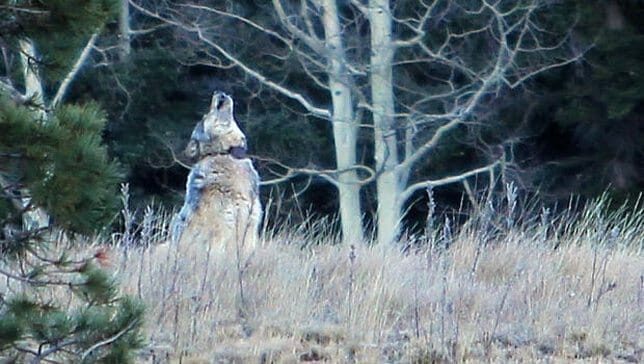
Article Written by: S. Jefferson of TrailMob.com
Today (November 3, 2014) the Center for Biological Diversity identified large swathes of land suitable for Gray Wolf Habitat. The report, Making Room for Wolf Recovery: The Case for Maintaining Endangered Species Act Protections for America’s Wolves, analyzed 27 published research papers that show appropriate wolf habitat. While currently only a handful of states in the lower 48 have wolf populations, the report contends that up to 19 states have areas that could support populations, including, California, Utah, Colorado, Texas, Arizona and eastern states such as upstate New York through Maine. Currently there are an estimated 5,400 wolves in the contiguous United States, most of which live in the Northern Great Lakes and Northern Rocky Mountains. The study suggests that number could effectively be doubled by establishing populations in suitable habitats.
The study’s findings come just days after a likely Gray Wolf wandered from the Rocky Mountains to the north rim of Grand Canyon National Park – the first wolf in the park in nearly 75 years. Officials with various wildlife services are quick to point out that the wolf is unconfirmed as of this writing, however, by simply looking at this photo you can clearly see the research collar on the large canid.
This report and those of possibly the world’s most famous wolf, OR-7, seemingly show that while wolf recovery is being hailed a success, there are still plenty of other areas where the predators can flourish. Both the yet to be named Grand Canyon wolf and the now proud father OR-7 traveled thousands of miles from where they were pups looking for new territory and a mate. OR-7 has found his mate and is currently thought to be living with his new family in Oregon’s Rogue River-Siskiyou National Forest in the southern Cascades. This is the first litter of wolves in the southern cascades in decades and before he settled down for family life, he temporarily crossed into California, becoming the first wolf in the Golden State in nearly 90 years.
Wolf, Credit Arizona Fish and Wildlife
As wolves naturally return to bits and pieces of their historic range, the Obama Administration is prepping to make that journey much harder. The current administration is moving towards removing Endangered Species Protection from Gray Wolves, despite them having returned to less than ten percent of their historic range. One need not look far from TrailMob’s own headquarters to see what happens when protections are removed from wolves and handed over to state governing agencies. Idaho has a government sanctioned Wolf Control Board whose sole purpose is to reduce the number of wolves in the state to 150, approximately the very minimum possible to keep the federal government at bay. Idaho’s neighbor to its east, Wyoming, has essentially taken a stand-off approach with the federal government over wolves and thus far has been unable to have wolves protection-free on a continuous basis. The state regards wolves as vermin and has a shoot-on-sight policy. The loudest battle cries are those from big game hunters who often cry they ‘kill our elk’ or the coveted ‘we don’t need some East-coaster telling us how to manage our state.’ While both sentiments may be true, there are still laws that must be followed. To be clear, I am not necessarily anti-hunting, just are pro-common sense.
One look at Yellowstone National Park’s ecosystem before and after the reintroduction of wolves and it’s clear that wolves have a place in our natural world. Yes, wolves kill elk and deer, as is expected with an alpha predator. However, that does not mean they are not there; rather, elk and deer have adapted to wolves and have become more secretive. Many believe they are now at healthier numbers within the park. Park biologists have noted many pleasant surprises as a result of the wolves thriving in the park. As Yellowstone’s wolves lowered the number deer and elk, the amount of vegetation consumed by hooved mammals also fell. Further unexpected side-effects wowed biologists.
The vegetarian deer and elk had been decimating plants in the parks valleys. With them being forced to hills, trees and other undergrowth quickly returned. With that came new songbirds, and larger trees allowed for the beaver population to rebound, which in turn created prime habitat for river otters, waterfowl and fish. Wolves don’t just kill trophy elk; they dropped the coyote numbers tremendously in the park. Fewer coyotes meant rabbits and other small rodents were able to rebound. Greater numbers of small mammals meant more prey for small predators such as foxes, badgers and birds of prey whose numbers have all seen increases.
OR-7, Photo Credit US Fish and Wildlife
Kills abandoned by wolves have become feasting grounds for other carrion-loving raptors such as Bald Eagles and Turkey Vultures. And to the delight of many Yellowstone visitors, the park’s Grizzly Bear numbers are on the rise as well. You guessed it; a new study points to the reintroduction of wolves as the reason. Two reasons in particular are cited: 1) wolves keep elk populations down, which in turn allow berries to flourish, allowing Grizzlies to fatten up for winter, and 2) if a grizzly wants to snack on a wolf kill, it’s going to, letting the wolves do the hard part while it reaps the rewards. Lastly, wolves have literally helped reshape Yellowstone. With thick vegetation returning to the park’s valleys, it has allowed for deep roots to be established and thereby curbed erosion along the parks waterways. While wolves compete with hunters for big game, their ecological value cannot go unnoticed.
Currently, under the Endangered Species Act, wolves that roam outside of established areas remain protected; however, if the Obama Administration lifts the Gray Wolves’ protection nationwide, such wolves will be fair game anywhere they roam. If this were to happen, wolves would be precluded from entering territories that they are clearly capable of surviving in, as demonstrated by the Grand Canyon’s Lone Wolf and OR-7, and we would lose out on the numerous environmental benefits, such as those evident in Yellowstone National Park.
Grizzly Bear on a Carcass, Photo Credit Jim Peaco, NPS
Find the original article and more at TrailMob.com







